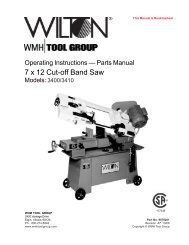This Rigger's Handbook is dedicated to Theodore C - Igor Chudov
This Rigger's Handbook is dedicated to Theodore C - Igor Chudov
This Rigger's Handbook is dedicated to Theodore C - Igor Chudov
You also want an ePaper? Increase the reach of your titles
YUMPU automatically turns print PDFs into web optimized ePapers that Google loves.
YOUR SLING AND RIGGING SPECIALIST<br />
RIGHT WAY. Set the machin<strong>is</strong>t's caliper <strong>to</strong> read the<br />
widest diameter. Vernier scale reads <strong>to</strong> 1/128th of<br />
an inch.<br />
WRONG WAY. <strong>Th<strong>is</strong></strong> <strong>is</strong> the wrong way <strong>to</strong> measure<br />
wire rope diameter. Widest diameter <strong>is</strong> not being<br />
read.<br />
SHEAVES SHOULD BE CHECKED FOR:<br />
1. Correct groove diameter<br />
2. Roundness or con<strong>to</strong>ur <strong>to</strong> give proper support <strong>to</strong> the rope<br />
3. Small holes, cracks, uneven surfaces, or other defects that<br />
might be detrimental <strong>to</strong> the rope<br />
4. Extreme deep wear<br />
A sheave should also be checked <strong>to</strong> make sure it turns freely,<br />
<strong>is</strong> properly aligned, has no broken or cracked flanges, and has<br />
bearings that work properly.<br />
Drums should also be inspected for signs of wear that could<br />
damage rope. Plain-faced or smooth drums can develop<br />
grooves or impressions that prevent rope from winding<br />
properly. Repair by resurfacing the face or replacing the<br />
lagging.<br />
Scrubbing will occur if the rope tends <strong>to</strong> close wind. If the<br />
tendency <strong>is</strong> <strong>to</strong> open winding, the rope will encounter abnormal<br />
abuse as the second layer forces itself down between the<br />
open wraps of the first layer on the drum.<br />
Operating with a smooth drum calls for special care. Be sure<br />
the rope <strong>is</strong> always tightly wound and thread laid on the first<br />
layer. Any loosening of the line <strong>is</strong> easily observed as the<br />
winding will be bad and the rope will be coming off with a<br />
series of "bad spots."<br />
Grooved drums should be examined for tight or corrugated<br />
grooves and for differences in depth or pitch that could<br />
damage the second and subsequent layers. Worn grooves<br />
can develop extremely sharp edges that shave away small<br />
particles of steel from the rope. Correct th<strong>is</strong> condition by<br />
grinding or filing a radius <strong>to</strong> replace the sharp edge.<br />
Drum flanges, as well as the starter, filler and r<strong>is</strong>er strips,<br />
should be checked. Excessive wear here often causes<br />
unnecessary rope abuse at the change of layers and crossover<br />
points.<br />
Other places of contact such as rollers, scrub boards, guides<br />
and end-attachments should also be inspected.<br />
MEASURE THE WIDEST DIAMETER<br />
Ropes and sheave grooves must be prec<strong>is</strong>ely fitted <strong>to</strong> each<br />
other <strong>to</strong> get the most service out of your wire rope dollar.<br />
Make measurement of rope diameter a normal part of your<br />
inspection program.<br />
There's only one right way <strong>to</strong> measure rope diameter: use<br />
machin<strong>is</strong>t's calipers and be sure <strong>to</strong> measure the widest<br />
diameter. The drawings at the left compare the right way with<br />
the wrong way.<br />
<strong>Th<strong>is</strong></strong> method <strong>is</strong> not only useful for measuring the diameter of<br />
a new rope, but also for determining the amount of wear and<br />
compression that has occurred while the rope has been in<br />
use. Accurate recording of th<strong>is</strong> information <strong>is</strong> essential in<br />
helping <strong>to</strong> decide when <strong>to</strong> replace wire rope.<br />
HEADQUARTERS: 55 James E. Casey Drive • Buffalo, NY 14206 PHONE: 716.826.2636 FAX: 716.826.4412 www.hanessupply.com<br />
127<br />
Wire Ropes
















